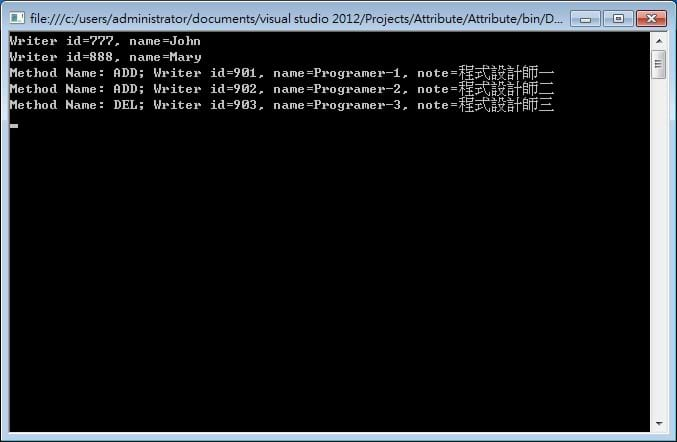C#中的Attribute屬性(特性)用法
經常在C#的範例程式碼中,看到在類別Class、方法Method上面,帶了一個中括號,裡面寫了一些蠻語意化的字串。這個東西在C#語言裡面用到不少,它源自於System.Attribute,並且在.NET的整體架構中佔了很重要的一環。
Attribute在英文中的意思是指「屬性」,但是這與我們一般在程式語言中理解的屬性是完全不一樣的意思的,更進階一點來說應該翻成「特性」才對。一般來說,在普通的程式碼環境根本不會用到這種Attribute語法,只有在特別的時期,例如Win32 DLL的引用[DllImport],或者是Object Serializable時,才會使用到,Attribute是編譯時期的產物,像剛才講的這兩個時機點,都是要跟編譯器描述(講)一些資訊,以利其編譯之動作。
更簡單的說,Attritube最主要的目的,就是可以提供延伸的資訊給程式碼參考,並可動態去修正後續要進行的動作。
基於上述的理由,我們建立一個CMD環境的程式碼,其中包含了一個自訂的特性類別「Writer」,用來記錄這一段程式是由誰來撰寫,以及相關的參考參數可以取出。另外一個「SomeClass」則是真正的把Attribute的寫法使用上去,你可以發現它甚至可以拿來當成程式碼的註解來使用(這也是這個無用的範例假設的情境),無論是Class或Method都可以支援Attribute,且可以不只一個Attribute。
※註:可支援Attribute的寫法包含了組件Assembly、Module、Type、Property、Event、Field、Method、Param、Return等。
最後我們可以從主控台Main這邊,來進行這兩個類別的操作,程式碼以及相關說明如下:
namespace Attribute
{
class Program
{
static void Main(string[] args)
{
//取出操作對象的Type
System.Type oType = typeof(SomeClass);
//利用反射取出成員資訊(記住Reflection蠻很耗效能)
System.Reflection.MemberInfo oItemInfo = oType;
/*取出類別上方的Attribute*/
//取出類別Class中隱含的屬性(0筆至多筆)
foreach (Writer oWriter in System.Attribute.GetCustomAttributes(oItemInfo))
{
System.Console.Write("Writer id={0}, ", oWriter.id.ToString());
System.Console.WriteLine("name={0}", oWriter.name);
}
/*取出方法上方的Attribute*/
//取出這個類別裡面的所有方法
foreach (System.Reflection.MethodInfo oMethod in oType.GetMethods())
{
//取出類別Method中隱含的屬性(0筆至多筆)
foreach (var oTemp in System.Attribute.GetCustomAttributes(oMethod))
{
//因為有可能取到.ToString()之類的繼承方法,那些並不是我們所需要的,所以必須過濾掉
if (oTemp.GetType() == typeof(Writer))
{
Writer oWriter = (Writer)oTemp;
System.Console.Write("Method Name: {0}; ", oMethod.Name);
System.Console.Write("Writer id={0}, ", oWriter.id.ToString());
System.Console.Write("name={0}, ", oWriter.name);
System.Console.WriteLine("note={0}", oWriter.note);
}
}
}
System.Console.Read();
}
}
//無聊的示範類別(單純的示範這個程式用來記載某個類別方法是「誰」寫的)
[Writer(id=777, name="John")]
[Writer(id=888, name="Mary")]
class SomeClass
{
[Writer(id=901, name="Programer-1", note="程式設計師一")]
[Writer(id=902, name="Programer-2", note="程式設計師二")]
public string ADD()
{ return "Method ADD has been run."; }
[Writer(id=903, name="Programer-3", note="程式設計師三")]
public string DEL()
{ return "Method DEL has been run."; }
}
//自訂Attribute類別,一定要繼承System.Attribute
//且可藉由上方的Attribute來進行細部的設定(例如多Attribute的AllowMultiple設定)
[System.AttributeUsage(
System.AttributeTargets.All,
Inherited=false,
AllowMultiple=true)]
class Writer : System.Attribute
{
public int id { get; set; }
public string name { get; set; }
public string note { get; set; }
}
}
由上面的程式碼中,我們可以在執行期時,求得正在運行中的類別的「相關註解」,也可以針對正在運行中的類別中的某個方法進行求取「相關註解」,至於這個「相關註解」到底要幹嘛,就得看你後續的程式的需求了。執行出來的畫面如下:

在Attribute的應用中,如果你用到的是自訂Attribute特性,其實最後大多是準備要用於晚期繫結,不然在執行期要這些無聊的類別註解資訊要幹嘛?晚期繫結在.NET裡面的實作就叫做Reflection,中文稱為反射,這個留在「C#中的Reflection反射(反映)用法」中再來探討。
相關連結:
利用Attribute Type打造一個類MVC的驗證
利用Attribute為ORM型別的屬性添增新色彩
C# Attribute 屬性 特性 中括號 Reflection